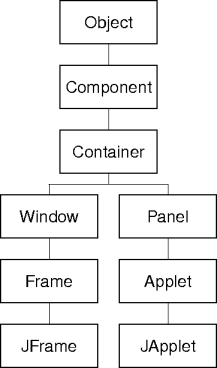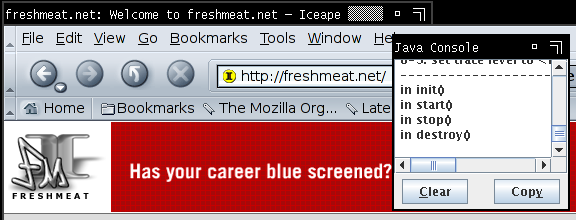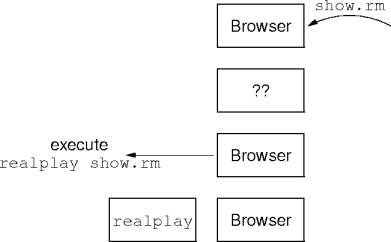
|
|
public voidinit()Applet loaded. public voidstart()Applet visible. public voidstop()Applet occluded. public voiddestroy()Applet gone.

import java.applet.Applet
public class sa
extends Applet
@Override public void init()
System.out.println("in init()")
@Override public void start()
System.out.println("in start()")
@Override public void stop()
System.out.println("in stop()")
@Override public void destroy()
System.out.println("in destroy()")


init(): Called once after the applet's been loaded. Set-up the
applet, acquire resources. Favor init() over a default constructor.
start(): Called when the applet becomes visible. Start doing
whatever the applet does (if anything).
stop(): Called when the applet is no longer visible. Stop doing
whatever the applet does (if anything).
destroy(): Called once when the applet's no longer needed. Release
resources acquired by the applet.
init(), not a constructor,
start(), not a main(),
destroy(), not a setDefaultCloseOperation(),
setSize(),
<title></title> tag, not setTitle(),
start() and stop(), not setVisible().
<html> <head> <title></title> </head> <body> This is a background <applet code = "sa.class" height = 0 width = 0> </applet> applet. </body></html>
code: a URL to an applet class.
height and width: the applet real-estate height and width
in pixels (required).
<applet code = "sa.class" height = 0 width = 0> </applet>
$ls public-html dragon-curve.html DragonCurve.class DragonCurve$LineSegmentIterator.class DragonPanel$1.class DragonPanel.class DragonPanel$MouseHandler.class DragonPanel$KeyHandler.class $
codebase attribute specifies an alternative directory for
class files.
codebase is like a one-entry class path.
codebase paths start at the HTML page directory.
<applet code = "DragonCurve.class" height = "500" width = "500" codebase = "../applets">
archive attribute is a list of URLs for jar file containing
supporting class files.
<applet code = "EaglesWing.main" height = 500 width = 500 archive = "model.jar,view.jar,controller.jar">
<applet code = "show-quotes.class" height = 10 width = 10> <param name = "count" value = "10"/> <param name = "ibm" value = "123.23"/> <!- blah blah blah -> <param name = "red hat" value = "19.41"/> </applet>
getParameter() method reads paramter values from the applet-tag
body.
<object codetype = "application/java" classid = "java:DragonCurve.class" height = 100 width = 100> </object>
about:plugins url to check your browser's set of installed
plugins.

|
|
|
|
System.out and
err.
|
|
|
x Java-console command.
<applet code = ... alt = "[Enable Java to see this applet.]" > [Install the Java plug-in to see this applet.] </applet>

.jnlp extension, or
application/x-java-jnlp-file MIME type.
javaws (Java Web Start) is the externally implemented sandbox.
javaws sandbox is a bit less constrained than the in-browser
sandbox.